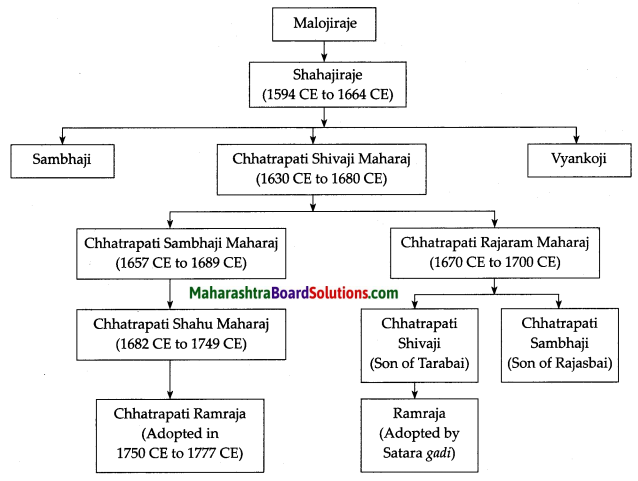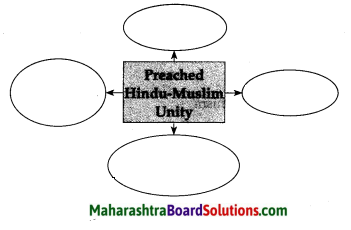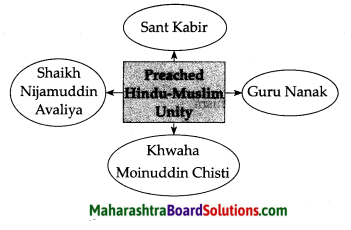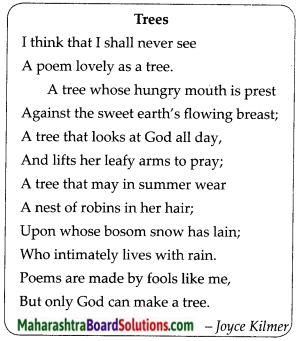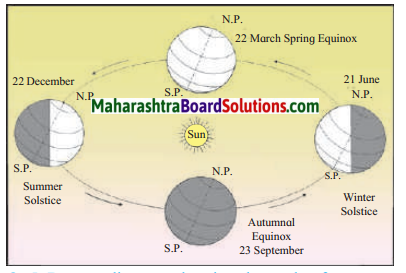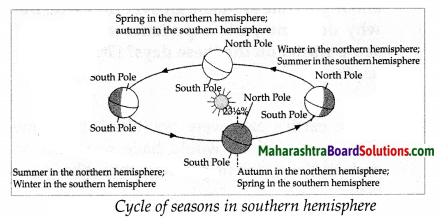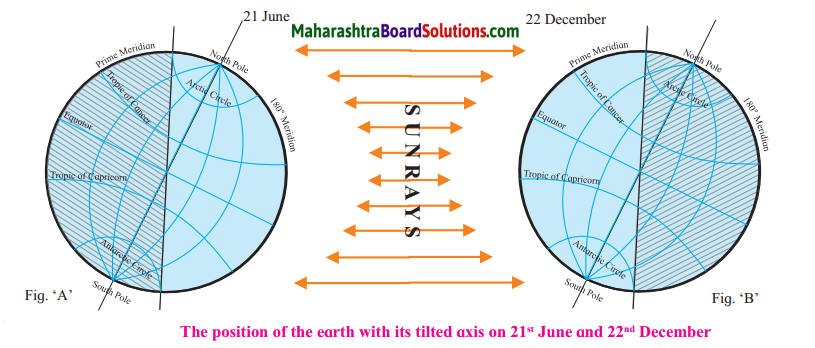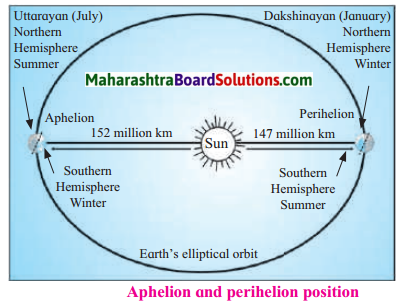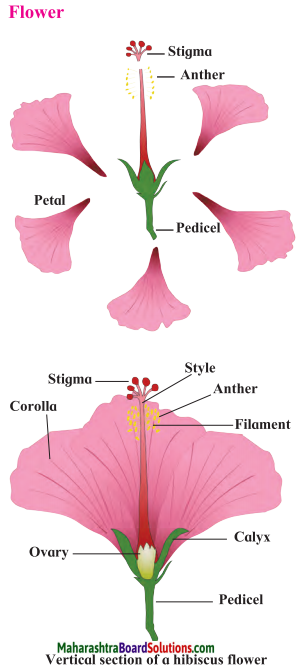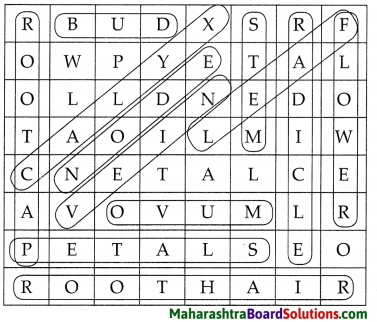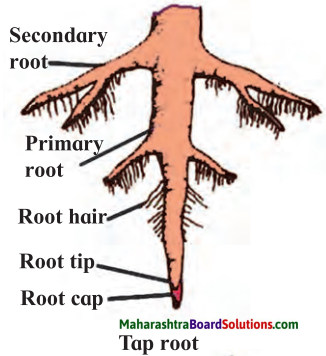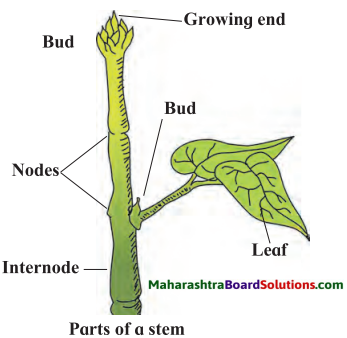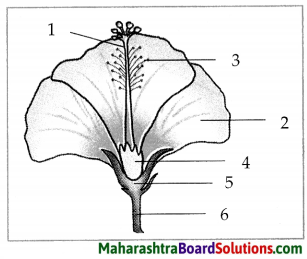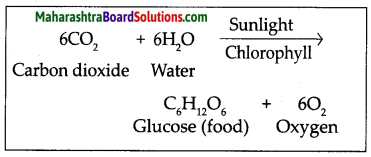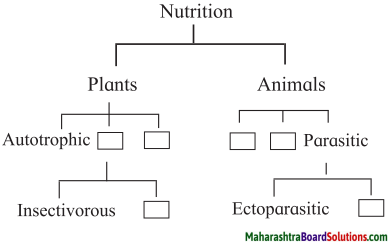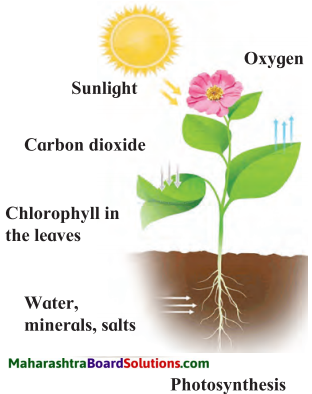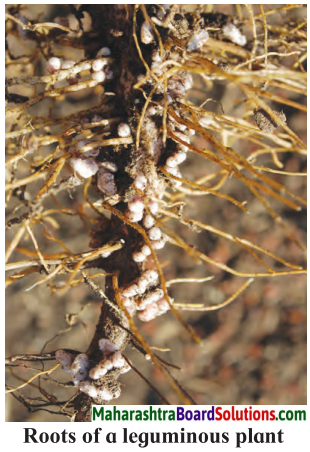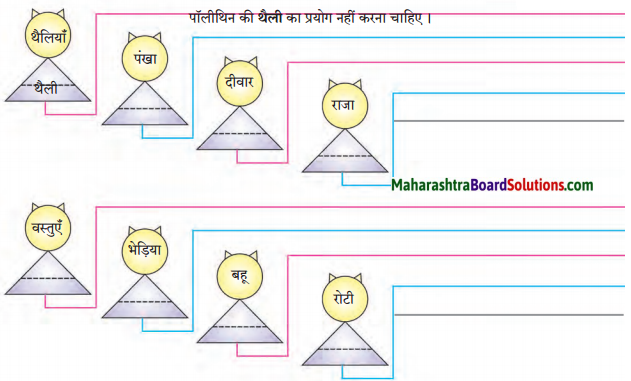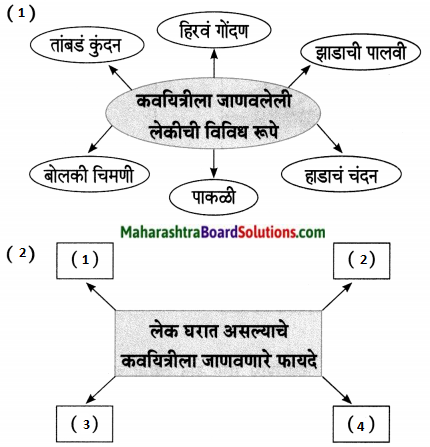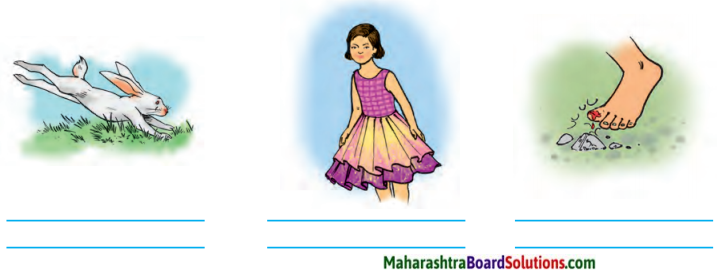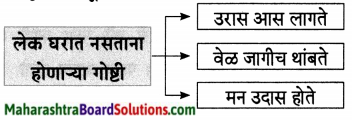Balbharti Maharashtra State Board Class 7 English Solutions Chapter 4.3 The Red-Headed League Notes, Textbook Exercise Important Questions and Answers.
Maharashtra State Board Class 7 English Solutions Chapter 4.3 The Red-Headed League
Class 7 English Chapter 4.3 The Red-Headed League Textbook Questions and Answers
Part-I
1. Find and write the descriptions of different people given in this story.
Red Headed League Questions And Answers Question 1.
Find and write the descriptions of different people given in this story.
Answer:
Character Sketch:
a. Sherlock Holmes: A private detective and the story’s protagonist. His keen observations and ability to reason allowing him to solve puzzles that astonish everyone. Sometimes quiet and contemplative, other times bursting with energy, he uses methods that can confuse and frustrate others. He is somewhat a mystery, rarely letting his thoughts known until he has already solved the crime.
b. Dr. John Watson: Sherlock Holmes’ partner and the story’s narrator. Good natured, brave and down-to-earth, Watson is Sherlock Holmes’ sidekick, even though he rarely helps Holmes actually solve any mysteries and Watson often mirrors the reader’s own confusion.
c. Jabez Wilson: A London pawn-broker, Jabez Wilson is an average man whose only remarkable feature is his lock of fiery red hair. His slow and trusting nature prevented him from seeing anything suspicious about either Vincent Spaulding or the preposterous Red-headed League.
d. John Clay / Vincent Spaulding: A notorious criminal working at Jabez Wilson’s pawnshop under the name of Vincent Spaulding. He is evil and haughty. John Clay catches the attention of Sherlock Holmes in spite of his clever plot.
e. Duncan Ross: John Clay’s partner-in-crime. Duncan’s red hair prompts John Clay to devise the Red-headed League to lure Wilson out of his pawnshop for four hours everyday.
![]()
2. Present Mr. Wilson’s story as it would be shown in a comic strip.
The Red-Headed League Questions And Answers Question 1.
Write what picture you will show in each frame along with the dialogues. Write the dialogue with the help of the story. Examples:
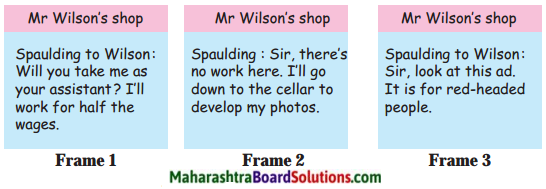
Answer:
Frame 1.
Mr. Wilson’s shop:
Spaulding to Wilson: Sir, why don’t you try for this job?
Frame 2.
Mr. Wilson’s shop:
Spaulding to Wilson : It is to help the red-heads.
Frame 3.
Mr. Wilson’s shop
Spaulding to Wilson: They are paying handsomely. It will be an additional income for you.
Frame 4.
Mr. Wilson’s shop:
Spaulding to Wilson: Sir, I will go along with you. Let’s give it a try.
![]()
Frame 5.
At Fleet Street:
Wilson to Spaulding: Just see! It is crowded with red-headed people. I don’t stand a chance.
Frame 6.
At Fleet Street:
Spaulding to Wilson: Sir, don’t be disheartened.
Frame 7.
At Fleet Street:
Spaulding to Wilson: Sir, stay by my side. I’ll push you into the office.
Frame 8.
At the office:
Wilson to Spaulding: At last, we are in the office, but there is no one except one man.
Frame 9.
At the office:
Spaulding to Wilson: Sir, you don’t worry. Just answer his questions confidently.
Frame 10.
Mr. Duncan Ross to Wilson:
I’m pleased with your confidence. I’m glad to announce that you have got the job.
Frame 11.
At Fleet Street:
Wilson to Ross: Thank you so much, Sir. I’m highly obliged.
![]()
Frame 12.
At the office:
Wilson to Ross: Sir, what am I supposed to do? How much will I be paid?
Frame 13.
At Fleet Street:
Ross to Wilson: You will have to copy the encylopedia Britannica. You will be paid four pounds a week. And: your timings will be from 10 am to 2 pm.
Frame 14.
At the office:
Wilson to Ross: Wonderful Sir, when do I start?
Frame 15.
At the office:
Ross to Wilson: Mr. Wilson, you begin from tomorrow.
Frame 16.
At the office:
Wilson to Ross: Sir, I will put my heart and soul into my job.
Ross to Wilson: You will have to begin with one letter A and go alphabetically.
Wilson to Ross: Ok, Sir.
![]()
Frame 17.
At Wilson’s shop:
Spaulding to Wilson: How is your job going?
Wilson to Spaulding: Well I am enjoying it. Mr. Ross is visiting the office every day. He is very much particular about my timings.
Frame 18.
At the office:
Ross to Wilson: How are you finding your work? This is your salary.
Wilson to Ross: Thank you, Sir.
Frame 19.
At Wilson’s office:
Spaulding to Wilson: How are you Sir and how is your job going?
Wilson to Spaulding: It’s been 8 weeks and 1 am really enjoying. Now Mr. Ross has stopped coming to the office.
Frame 20.
At Wilson’s shop:
Spaulding to Wilson: Good morning. What happened today? You did not go out?
Wilson to Spaulding: The office of the League is shut and locked. There is a note nailed on the door saying the League is dissolved.
Frame 21.
At Wilson’s shop:
Wilson to Spaulding: Do you know anything about the League?
Frame 22.
At Wilson’s shop:
Spaulding to Wilson: 1 am unaware about what happened.
![]()
Frame 23.
Wilson to himself:
I should find out more about the League. This is a mystery and I want to know why they played this prank upon me.
Frame 24.
Wilson to himself:
Sherlock Holmes will be the best person to solve this mystery. I will go to him.
3. Form groups of five. Discuss how you can complete the rest of the story without referring to Part II of the story.
The Red Headed League Questions And Answers Question 1.
Form groups of five. Discuss how you can complete the rest of the story without referring to Part II of the story.
Answer:
Mr. Holmes and Watson try to think out why the League shut so abruptly. Holmes feels he should meet Wilson at home to ask some questions that were bothering him. When he reached Wilson’s house, he notices someone leaving the house. Mr. Holmes enquires about that person and understands that he was Wilson’s assistant. Mr. Holmes feels that he has seen the assistants face before.
Later, he checks on records and finds out that the assistant is none but a notorious criminal clay who was absconding. Mr. Holmes already had a sketch of Mr. Ross. On enquiring he came to know that Ross and Spaulding were very close. Mr. Holmes goes to Mr. Ross’ house and threatens him. Mr. Ross spills the beans, that he and Spaulding were going to rob Mr. Wilson the very next day. Mr. Holmes informs the police and both Spaulding and Ross are caught and put behind bars.
![]()
4. Language Study.
Modal auxiliary: You have read about main verbs and auxiliary verbs in Sid VI. You know that auxiliary verbs are helping verbs. Modal auxiliary verbs or modal verbs are also helping verbs. They are used with main verbs to show changes/modifications in the meaning of the main verb. They show possibility, ability, permission, intention, etc.
The modal auxiliaries are:
- can, may, shall, will
- could, might, should, would
- must, ought to, used to, need, dare ………
Remember the following:
- We do not use ‘to’ before a modal.
- We do not add ‘-ed’ or ‘-Ing’ to a modal.
- We can form questions and negative sentences using modals without using the auxiliaries be, have, or do.
Examples:
- They can swim.
- May I come In?
- We shall sing.
- Can he swim?
- You may go.
- She ought to play.
- He cannot swim.
- You must go.
- They might come.
Frame simple sentences – statements, questions, requests. orders, permissions, etc. using the modals listed above.
Answer:
- Take an umbrella. It may rain today.
- You should not leave objects lying on the floor.
- Drivers must stop when the traffic light is red.
- Can you speak French?
- I could not solve the problem.
- May I ask you a question?
- You may take a holiday today.
- You should see a doctor.
- I could run fast when I was young.
- Can I go out?
- You need not buy any vegetables.
- Students shall not enter this room.
- What should I do to get rid of this pain?
The Red Headed League Question Answer Part – II
1. Put the following events in proper order.
The Red-Headed League 7th Standard Question Answer Question 1.
Holmes and others go to the bank.
Answer:
The bank received a lot of gold from the Bank of France.
![]()
Questions Answers Of Red Headed League Question 2.
Clay digs a tunnel.
Answer:
Clay digs a tunnel.
The Red Headed League Std 7 Question 3.
Ross closes the office of the ‘Red-headed League’.
Answer:
Ross closes the office of the ‘Red-headed League’.
The Red-Headed League 7th Standard Question 4.
Holmes catches the criminal Clay.
Answer:
Holmes visits the area around Mr. Wilson’s shop.
Std 7 English The Red Headed League Question 5.
Clay and Ross enter the cellar to steal the gold.
Answer:
Holmes and others go to the bank.
The Red Headed League Questions And Answers Question 6.
The bank received a lot of gold from the Bank of France.
Answer:
Clay and Ross enter the cellar to steal the gold.
![]()
The Red Headed League Question And Answer Question 7.
Holmes visits the area around Mr. Wilson’s shop.
Answer:
Holmes catches the criminal Clay.
2. From the passage, find adverbs that end with ‘-ly’.
Question a.
From the passage, find adverbs that end with ‘-ly’. Find the adjective in each of the adverb
Answer:
| Adverb | Adjective |
| frankly | frank |
| silently | Silent |
| carefully | careful |
| finally | final |
| suddenly | sudden |
| beautifully | beautiful |
3. Discuss the following elements of a detective or mystery story.
Question a.
Discuss the following elements of a detective or mystery story.
- a mystery
- strange happenings
- a smart detective who investigates the happenings
- a crime/possibility of a crime
- preventing the crime and catching the criminal.
- characteristics of the victim
- characteristics of the criminal
- characteristics of the detective
Use the elements to prepare outlines of detective stories using your imagination. Write a story using any one of the outlines.
Answer:
Outline:
- Disappearance of the ‘Will’.
- Death of the head of the family.
- Wife and two sons left behind.
- ‘Will’ to be read before family members.
- The elder brother in charge of the ‘Will’.
- He makes excuses of misplacing the ‘Will’ and shows the photocopy of the ‘Will’.
- The family lawyer insists on the original ‘Will’.
- The elder brother keeps insisting on having lost the ‘Will’.
- Mr. Karamchand, a clever and intelligent detective called.
- The detective makes the necessary enquiries.
- The elder brother, a gambler, a revelation.
- The detective catches the elder brother in his own act.
- The elder brother owns up.
- The lawyer with the help of the detective prevents a big crime from being executed.
![]()
Caught in his own act:
The disappearance of the ‘Will’ was a mystery in the Patwardhan family. The disappearance of the ‘Will’ came to light when it had to be read by the family members after the death of senior Mr. Patwardhan. Mr. Patwardhan had left behind a lot of property and wealth. Mr. Patwardhan had left behind his wife and two sons. When the family lawyer enquired about the ‘Will’, Mrs Patwardhan said that she had given it to her elder son who had said that he would keep it safely. The younger son was unaware of the ‘Will’ made by his father.
When the lawyer of the family asked him if he had read his father’s ‘Will’, he realised what they were saying and asked his mother to show the ‘Will’, she said that it was with her elder son. When the elder son was asked about the ‘Will’, he started making excuses by saying he had misplaced the ‘Will’ and could not find it. The family lawyer insisted that the ‘Will’ be shown to the younger son.
The elder son brought a photocopy of the ‘Will’. The younger son and the family lawyer demanded the original ‘Will’. The elder son kept on making excuses and also said that the original ‘Will’ was lost. There was something in this situation which was a mystery. This is when the younger son hires a smart and intelligent detective, Mr. Karamchand. Mr. Karamchand makes a lot of enquiries and comes to know that the elder son was in the habit of gambling and was in a lot of debts.
Mr. Karamchand also came to know that the elder son was a very sweet talker and could twist and turn situations to his advantage. On the other hand, the younger brother was quite a simpleton who was happy with what he had, making it easier for the elder brother to manipulate him.
Their mother being quite old, had bouts of memory loss. This was another good reason for the elder son to do as he pleased. Mr. Karamchand, very cleverly got the truth out from the elder son. Mr. Karamchand informed the family lawyer, who in turn, demanded the original copy of the ‘Will’ from the elder son.
The lawyer also told him that it was a crime not to show the ‘Will’ to the family members. The elder brother showed the ‘Will’ to the younger brother. The younger brother read the ‘Will’ and handed it to the family lawyer without suspecting anything. The family lawyer went through the ‘Will’ and found out that the ‘Will’ had been tampered with. The dates and certain words were changed for the benefit of the elder brother.
After a lot of interrogation, the elder brother accepted the crime committed by him. The family lawyer rectified the changes made and now the younger brother got his share of property and wealth.
4. Use the following outline to develop a story as a group activity. Then write the story individually.
Question a.
Family returns home late at night ……………. hear conversation between thieves from inside the locked house ……………. family gets ready to counter …………….. attack …………… father opens the …………… door ……………. all enter ………….. no one is seen ……………… but T.V. is on detective serial midway.
Answer:
A Family Drama:
After attending the reception cum dinner of their close friend’s daughter, at the famous five star hotel ‘The Oberoi’, Mr. Pai and his family were returning home discussing the evening. Mr. and Mrs Pai along with their two children Suhani and Soham had attended the function. It was quite late at night, and to add to it, it began to rain making the surroundings dark and scary.
Mr. Pai drove the car cautiously and reached their colony safely. Mr. Pai parked the car while the others waited for him at the entrance of their building. It was still raining and the watchman was nowhere in sight. The common light in the building was not on. The way leading to their house was in darkness. Somehow they gropped their way to the second floor, where they lived. As they reached their house, Mr. Pai felt that he heard footsteps and whispering coming from inside their house. He asked his wife to listen carefully and she too agreed that there was whispering. The conversation indicated robbers searching for valuables. There was no light in their house.
Mr. Pai was an army officer. He asked his family members to stand behind him and he opened the main door very slowly. He could hear conversation and movements too. He slowly went towards the bedroom from where the conversation was coming. The door was closed.
He took out his revolver and pushed the door open quickly only to understand that the conversation was from the T.V. serial ‘Crime Patrol’. He then remembered that he had been watching T.V. before leaving home and had forgotten to switch it off. The other family members who had followed him gave a huge sigh of relief.
![]()
5. Language Study.
Synonyms, antonyms, homonyms: Synonyms are the words from the same language that have the same or more or less the same meaning.
Examples:
- good – nice – pretty
- shut – closed – sealed
- intelligent – bright
Antonyms are words from the same language that have opposite meanings.
Examples :
- strong – weak
- right – wrong
- hard – soft
- up – down
Homonyms are words that are spelt and pronounced in the same way but
have different meaning.
Examples
- round adjective. – round noun.
- walk noun. – walk verb.
![]()
Start a collection of synonyms, antonyms and homonyms. Collect at least 50 each. Keep adding to your selection.
Answer:
Examples of Synonyms:
- advice – help – guidance – aid
- argument – dispute – squabble
- aromatic – fragrant
- backbone – spine
- choosy – picky
- constant – fixed
- defective – faulty
- enormous – huge – immense
- famous – popular – renowned
- fantastic – great – brilliant
Examples of Antonyms:
- predator × prey
- employer × employee
- former × latter
- exhale × inhale
- natural × artificial
Examples of homonyms:
- bark (n) – bark (y)
- bow (n) – bow (y)
- clear (adj) – clear (y)
- current (adj) – current (n)
- fair (adj) – fair (n)
Class 7 English Chapter 4.3 The Red-Headed League Additional Important Questions and Answers
Answer the following questions:
The Red-Headed League Questions And Answers Pdf Question 1.
Who was well suited for the job?
Answer:
Mr. Wilson was well suited for the job.
![]()
The Red Headed League Answers Question 2.
What would you suggest/advice Mr. Wilson to do in the given situation?
Answer:
The best thing to do when you know a crime is being committed or you are being cheated is to go to the lawful authority. I would suggest/ advice Mr. Wilson to go to the police and file a complaint against the people who had cheated him. It is better to do so rather than taking matters into your own hands and make the situation worse.
The Red-Headed League Book Back Answers Question 3.
What did Holmes want to see? Why?
Answer:
Holmes wanted to see the knees of Mr. Spaulding’s trousers. It was to see if thery were dirty.
The Red Headed League Class 7 Question 4.
Guess where Mr. Merryweather took the others.
Answer:
Mr. Merryweather led the others through an iron gate, down a narrow passage, that led through a dark, passage into a huge cellar, full of big boxes.
The Red Headed League 7th Standard Question 5.
How did Mr. Merryweather come to know about the crime?
Answer:
Mr. Merryweather got a hint of the crime from Mr. Sherlock Holmes.
The Red Headed League Class 8 Question Answer Question 6.
Why did Mr. Holmes think the criminals would act that night?
Answer:
Mr. Holmes had a strong feeling that the criminals would act that night because it was a Friday and the banks and offices would be closed for the weekend making the work of the criminals easier.
![]()
Question 7.
How did the criminals enter the cellar?
Answer:
The criminals had made a square gash on the wall which separated Mr. Wilson’s house and the bank’s cellar. They removed a broad stone which left a square hole enabling the criminals to enter into the cellar.
Question 8.
Who were the two criminals?
Answer:
The two criminals were none other than Mr. Vincent Spaulding alias Clay and Mr. Duncan Ross.
Question 9.
Why did Holmes become suspicious?
Answer:
Mr. Holmes became suspicious when he heard that Mr. Spaulding, Mr. Wilson’s assistant worked for only half the wages.
Question 10.
How did Holmes find out that the assistant was a criminal?
Answer:
Mr. Holmes used Mr. Wilson’s description of his assistant, made further enquiries and found out that Mr. Spaulding was none other than Clay, a criminal.
![]()
Question 11.
How did Mr. Holmes guess that Mr. Spaulding was digging a tunnel?
Answer:
Mr. Holmes suspected that Mr. Spaulding was digging a tunnel because when Mr. Spaulding Clay. answered the doorbell, the knees of his trousers were wrinkled and stained and this confirmed his suspicion.
Reading Skills, Vocabulary and Grammar
Question 1.
Simple Factual Questions:
Match the columns.
| Columns ‘A’ | Columns ‘B’ |
| Mr. Hopkins | Representative of the Red-headed league |
| Mr. Wilson | American Millionaire |
| Vincent Spaulding | Pawnbroker |
| Mr. Duncan Ross | Assistant to Wilson |
Answer:
| Columns ‘A’ | Columns ‘B’ |
| Mr. Hopkins | American Millionaire |
| Mr. Wilson | Pawnbroker |
| Vincent Spaulding | Assistant to Wilson |
| Mr. Duncan Ross | Representative of the Red-headed league |
Complex Factual Questions:
Question 1.
Why did Wilson like his assistant Spaulding?
Answer:
Wilson liked his assistant Spaulding as he was smart, efficient and worked for only half the normal wages.
![]()
Question 2.
Why was Fleet Street full of red-headed people?
Answer:
There was an advertisement in the newspaper calling red-headed people in person to apply for a job at the office of the league. As the office was on Fleet Street, it was full of red-headed people.
Question 3.
What did Mr. Wilson think looking at the crowd?
Answer:
Seeing the crowd of red-headed people on the street, Mr. Wilson lost all hope of getting the job. Hence he wanted to go back.
Question 4.
What happened when Mr. Duncan Ross saw Mr. Wilson?
Answer:
Mr. Duncan was very pleased to see Mr. Wilson and announced immediately that he was well situated for the job. He sent back all the other candidates.
![]()
Question 5.
Why did Mr. Wilson accept the job?
Answer:
Mr. Wilson accepted the job because the pay was not only very good but also Spaulding assured Mr. Wilson that he would look after Mr. Wilson’s business in his absence.
Vocabulary.
Question 1.
Make 4 words of minimum 4 letters from the given words.
1. advertisement
2. representative
Answer:
1. adverse, verse, meant, said
2. present, pretest, native, resent
Question 2.
Give nouns form.
- smart
- efficient
- develop
- sat
- announce
- explain.
Answer:
- smartness
- efficiency
- development
- seat
- announcement
- explanation
![]()
Grammar.
Question 1.
There was nothing in the office but a couple of chairs and a table. Remove negative.
Answer:
There were only a couple of chairs and a table in the office.
Personal Response:
Question 1.
Who do you think is smarter – Mr. Wilson or his assistant?
Answer:
I think Mr. Wilson’s assistant, Spaulding was smarter. It was he who showed the advertisement to Mr. Wilson and urged and encouraged him to apply for the job. Seeing the large number of people trying to get the job, Mr. Wilson wanted to go back but spaulding pushed through the crowed and took him inside the office and saw to it that he got the job.
Question 2.
Would you like to do such a job?
Answer:
I would not like to do such a meaningless mundane and uninteresting job. Jobs should be interesting, challenging and provide scope for further learning and application of different skills which is totally absent in the job taken up by Mr. Wilson.
![]()
Question 3.
Why would anyone want to copy an encyclopedia?
Answer:
No one in their right sense would copy an encyclopedia/ However, for reference in some study, students as well as teachers could copy down specific matter they need. In the same very, someone who is challenging some matter given or want to upgrade it can copy relevant portion of an encyclopedia.
Question 4.
What would we do today, if we needed copies of text from a big book?
Answer:
Today, one would just take a photocopy xerox. of the required material.
Question 5.
What is the difference between a dictionary and an encyclopedia?
Answer:
An encyclopedia is a set of books with a collection of information about various topics and subjects while a dictionary contains meanings of different words. Both are arranged in alphabetical order.
![]()
Question 6.
Suggest a few words that may appear under ‘A’ after ‘Archery’ in an encyclopedia.
Answer:
Words that may appear under ‘A’ after ‘Archery’ in an encyclopedia could be as follows: architect, aromatics, asparagus, assassinator, astrobiologist, astrophysical, etc.
Simple Factual Questions.
Question 1.
Complete the following.
- And then suddenly the whole ……………
- The rooms had been rented ……………
- Holmes found Mr. Wilson’s story ……………
- Small, stout, with ……………
Answer:
- business came to an end.
- under a false name
- very unusual
- no hair on his face
Complex Factual Questions.
Question 1.
Why was Mr. Wilson shocked?
Answer:
Mr. Wilson has been working for eight weeks and as usual when he reached the office at ten o’ clock, he found the door shut and locked. He found a little note nailed on, it which said that the Red-headed league was dissolved. This shocked him.
![]()
Question 2.
What did Mr. Wilson do next?
Answer:
Mr. Wilson enquired at the nearly offices, but no one knew anything about the league.
Question 3.
Why did Mr. Wilson go to Mr. Holmes?
Answer:
Mr. Wilson felt cheated when he suddenly lost his job with a good pay. He was curious to find out about the league and why they played a prank upon him. He had also heard about the ability of Mr. Holmes to solve mysteries.
Question 4.
How did Mr. Wilson describe his assistant?
Answer:
Mr. Wilson described his assistant as small, stout, with no hair an his face and had a white splash of acid on his forehead.
Question 5.
What kind of a man was Mr. Wilson?
Answer:
Mr. Wilson was a simpleton. He could be easily taken for a ride. He was hardworking and diligent.
Vocabulary.
Question 1.
Give one word for the following.
- sincerely and tirelessly
- A playful trick that causes no harm
- Something which cannot be explained
- happening quickly and unexpectedly
- Solidly built
Answer:
- diligently
- prank
- mystery
- suddenly
- stout
![]()
Question 2.
Frame a sentence of your own with ‘diligently’.
Answer:
We must always work diligently.
Grammar.
Question 1.
On Saturday I got my salary. (Identify the subject and predicate)
Answer:
Subject-I
Predicate – got my salary on Saturday
Question 2.
I had written Abbots, Archery etc. (Begin with ‘Abbots…’)
Answer:
Abbots, Archery etc. had been written by me.
![]()
Question 3.
He did not come at all. Add a question tag.
Answer:
He did not come at all, did he?
Question 4.
Mr. Wilson wrote diligently for four hours. (Identify the part of speech of the underlined words)
Answer:
diligently – adverb
four – adjective
Question 5.
He locked the door of the office. (End with ‘……. the office’)
Answer:
Didn’t he lock the door of the office?
Personal Response.
Question 1.
What would you advice Mr. Wilson to do in the given situation?
Answer:
I feel Mr. Wilson made the right decision to take the help of Mr. Holmes about whom he had heard a lot.
![]()
Simple Factual Questions.
Question 1.
Complete the following.
- Mr. Holmes asked ……………
- The offices and banks will be ……………
- We followed him down a ……………
- We are in the cellar of the city branch of ……………
Answer:
- the way to the Strand
- closed for the weekend
- narrow passage
- one of the main banks of London
Complex Factual Questions.
Question 1.
Tell the name of the young man who opened the door to Mr. Holmes.
Answer:
The young man who opened the door to Mr. Holmes was his assistant Mr. Vincent Spaulding.
![]()
Question 2.
What announcement did Mr. Holmes make?
Answer:
Mr. Holmes announced that they were going to hunt one of the smartest criminals in London.
Vocabulary.
Question 1.
Provide suitable adjective to the nouns given below.
- weekend
- banker
- road
- passage
Answer:
- long weekend
- successful banker
- busy road
- interesting passage
Grammar.
Question 1.
We went to the square were Mr. Wilson had his shop. (Change into future tense.)
Answer:
We will go to the square where Mr. Wilson has his shop.
![]()
Question 2.
We followed him down a narrow passage. (Rewrite the sentence beginning…. He was followed….)
Answer:
He was followed by us down a narrow passage.
Personal Response.
Question 1.
Why did the criminals take interest in the cellar?
Answer:
Mr. Merryweather’s banks had borrowed a huge quantity of gold from the Bank of France and the boxes in the cellar were full of gold. Hence the criminals were interested in the cellar.
Complex Factual Questions.
Question 1.
Was Clay successful in using his revolver? Why?
Answer:
No, Clay was not successful in using his revolver because Mr. Holmes at once hit him on his wrist and the revolver fell on the floor.
![]()
Question 2.
Who came out of the square hole?
Answer:
Mr. Spaulding and Mr. Ross came out of the square hole.
Grammar.
Question 1.
A boyish face emerged. (Pick out the adjective)
Answer:
boyish
Question 2.
He had a companion with him. (Add a question tag)
Answer:
He had a companion with him, didn’t he?
Personal Response.
Question 1.
Who tried to get away? Do you think he was able to escape? Why?
Answer:
Mr. Duncan Ross tried to get away. But, he was not successful in escaping because there were three men waiting for him at the other end.
![]()
Simple Factual Questions.
Question 1.
Say if the statements are true or false.
- Dr. Watson foiled one of the cunning attempts at bank robbery.
- Using the tunnel they entered the bank.
- The assistant working for half the wages made Mr. Holmes suspicious.
Answer:
- False. It was’t Dr. Watson, if was Holmes,
- False
- True
Complex Factual Questions.
Question 1.
Why did Mr. Merryweather thank Mr. Holmes?
Answer:
Mr. Merryweather thanked Mr. Holmes as he had foiled one of the most cunning attempts at banks robbery.
![]()
Question 2.
What was strange about the advertisement?
Answer:
The advertisement and the peculiar job was purly to get Mr. Wilson away from his shop for some hours every day.
Question 3.
Why did clay and his companion dig the underground tunnel?
Answer:
Clay and his companion dug the underground tunnel to enter the bank and steal the gold without breaking open the doors of the bank.
Question 4.
What confirmed Mr. Holmes’ suspicion?
Answer:
When clay answered the bell, the knees of his trousers were wrinkled and stained, this confirmed his suspicion that he was digging.
![]()
Question 5.
“You reasoned it out beautifully!” Express it differently.
Answer:
You solved the puzzle very logically.
or
You connected the dots beautifully.
Vocabulary.
Question 1.
Averbs forms of.
- thank
- grateful
- obvious
- suspicious
- admiration
Answer:
- thankfully
- gratefully
- obviously
- suspiciously
- admirably
Grammar.
Question 1.
Pick four adjectives from the passage.
Answer:
cunning, cleaver, suspicious, beautifully
Personal Response.
Question 1.
Explain the trick of the ‘Red-headed League’. How was it related to Mr. Wilson’s hair?
Answer:
The ‘Red-headed League’ was a clever idea of Mr. Spaulding and Mr. Ross, to keep away Mr. Wilson from his own home for some time during the day so that they could dig a tunnel from Mr. Wilson’s house to the bank in the hope of stealing the gold from the bank without breaking open the doors of the bank. The ‘Red-headed League’ was no way connected to Mr. Wilson’s hair. It was just a way to get Mr. Wilson to apply for the job.
![]()
Language Study.
Question 1.
Complete the exercise by filling in with the right modals.
- You …………… be late again, (mustn’t / needn’t)
- You …………… do it now; you can finish it later. (mustn’t / needn’t)
- I think you ……………….. see a doctor, (should / can)
- …………… you help me? (May / Will)
- Students ……………… arrive to class on time, (can / must)
- I ……………. eat or I’ll faint, (ought to / would)
Answer:
- mustn’t
- needn’t
- should
- Will
- must
- ought to
Question 2.
- The ……………. (fare/fair) in the village was breathtaking. Fill in with the correct homophone.
- Mohan won a ……………. (meddle / medal) in the swimming competition. Fill in with the correct homophone.
- When it …………….(rains/reins), it pours. Fill with the correct word.
- We were early but they were ……………. (Fill in with the antonym of the underlined word)
- I (heard / herd) that the assistant worked for half the wages. (Cross out the wrong word)
- They planned to steal the gold. (Frame a ‘Wh’ question so as to get the underlined words as the answer)
Answer:
- fair
- medal
- rains
- late
- herd
Formative Assessment.
Question 1.
What do you have to do when you are told to ‘apply in person’ ?
Answer:
- i. Before applying for a job in person, it’s necessary to check out who is hiring.
- ii. Take time to research the employers before applying for jobs in person.
- iii. You have to know what you need to take when you go there.
- iv. The information youll need to complete a job application.
- v. How to prepare for, on the spot interview.
- vi. These points will guide you to provide all the information you need to apply in person, make a good impression and successfully get hired.
Question 2.
Find samples of ‘classified ads’ from an English newspaper. Where will the advertisement given here be seen in the classifieds?
Answer:
Samples of classified ads from The Times of India:

The advertisement given in the story will be seen in ‘Situations Vacant’ or ‘Part Time Jobs’.
Question 3.
Find out how photographs were developed in those days.
Answer:
Louis Daguerre was the inventor of the first practical process of photography.
Steps followed:
- Fix the image on a sheet of silver plate.
- Polish silver plate and coat it in iodine.
- Put plate in camera and expose it for a few minutes.
- Once image is painted by light, the plate is put into a solution of silver chloride.
- This process will create an image that would last a long time and will not get exposed to light.
- Students should find out more methods of photography.
The Red-Headed League Summary in English
This story is filled with mystery and suspense which keeps the reader wanting to know more. It is about a pawn-broker named Mr. Wilson, who goes to Sherlock Holmes and Watson and tells them about a strange business with a red-haired man. He tells them how his assistant encouraged him to apply for the job which he got. He worked for eight weeks. Suddenly the office closed without any notice. Holmes’ detective mind finds something fishy about the happenings as narrated by Mr. Wilson. The story ends with Mr. Wilson’s assistant Mr. Spaulding being a criminal, and he along with his friend Mr. Ross had planned to rob gold from a bank, through an underground tunnel dug out from Wilson’s house to the bank. However, Sherlock Holmes foiled their plan and put them behind bars.
Introduction:
The lesson The Red-Headed League’ is one of the 56 Sherlock Holmes’ short stories written by Sir Arthur Conan Doyle. It involves mystery and suspense.
![]()
Glossary:
- fiery (adj) – glowing
- pawn-broker (n) – a person who lends money on interest against things of value
- efficient (adj) – able to work well and produce good results
- assured (v) – guaranteed
- diligently (adv) – carefully, sincerely
- bade (v) – to tell
- dissolved (v) – disbanded (here) it means the organization was closed down.
- league (n) – an association or a formal group of people.
- prank (n)- playful trick that causes no harm.
- foiled (v) – laid waste, prevented
- splash (n) – sound made by something hitting the surface of some liquid.
- Strand (n) – a famous place in London
- cellar (n) – a room used for storage under a building
- take the criminals by surprise (phr) – catch then when they least expect it.
- object (v) – purpose, reason
- stopped all the holes (phr) – closed all the routes by which criminal may escape/run away
- seized by the collar (phr) – hold by the neck
- Frank (adj) – honest and outspoken
- gash (n) – a long deep cut
- attempt (v) – to endeavour to do, to try


